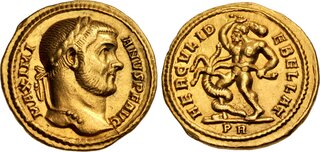| Classical Numismatic Group > Triton XXVII | Auction date: 9 January 2024 |
| Lot number: 870 Price realized: 11,000 USD (Approx. 10,075 EUR) Note: Prices do not include buyer's fees. | Show similar lots on CoinArchives Find similar lots in upcoming auctions on |
| Lot description: Maximianus. First reign, AD 286-305. AV Aureus (18mm, 5.52 g, 6h). Rome mint. Struck circa AD 293-294. MAXIMI ANVS P F AVG, laureate head right / HERCVLI D EBELLAT, Hercules, nude, standing left, battling the Lernaean Hydra, holding club overhead in right hand and grasping one of the heads of the Hydra with left; the Hydra coiled around Hercules' right leg to left. RIC VI –; Depeyrot 6/13; Calicó –; Biaggi –. Lightly toned and lustrous, a few faint marks, trace deposits. Near EF. Extremely rare. One other in CoinArchives. Well executed dies and in very high relief. Ex Numismatica Ars Classica 135 (21 November 2022), lot 377 (since conserved). The reverse of this issue depicts Hercules' battle with the Lernaean Hydra. The Hydra was the monstrous offspring of Typhon and Echidna, and the sibling of the Nemean Lion, the Chimaera, and Kerberos. It possessed numerous mortal and one immortal head on its single body; should one head be removed, two more would grow in its place. Tasked with vanquishing the beast for his second labor, Hercules traveled to the creature's lair – the spring of Amymone at the swamp near Lake Lerna in the Argolid. Hercules engaged the beast, wielding a harvesting sickle, and attempted to decapitate the creature. When this proved unsuccessful due to the Hydra's regenerative ability, Hercules enlisted the assistance of his nephew Iolaos, who devised a plan: once Hercules had cut off one of the creature's heads, Iolaos would cauterize the stump with a burning firebrand. The plan succeeded and the Hydra was destroyed. Hercules placed its one immortal head under a large rock on the sacred way between Lerna and Elaius and dipped his arrows in its poisonous blood. To the Tetrarchy, and particularly Maximianus, the British usurper Carausius was a type of Hydra – a problem that refused to go away and continued to rear its ugly head. Maximianus launched two failed attempts to defeat Carausius, who controlled Roman Britain in rebellion and much of the Gallic coastline across the Channel. Both expeditions ended in failure. After a couple years of preparations, a new expedition was launched in 293 in an effort to defeat the usurper once and for all. This time, the new Caesar, Constantius, spearheaded the campaign. After a number of victories in Northern Gaul, Constantius succeeded in forcing the surrender of Carausius' major port and stronghold of Gesoriacum (today's Boulongne-sur-Mer). This event precipitated Carausius' sudden downfall. He was assassinated in Britain shortly after the loss of the important city. Thus ended the reign of Carausius. Three years later, Constantius would succeed in eliminating his successor Allectus and reincorporate Roman Britain into the Empire. Estimate: 7500 USD |  |



